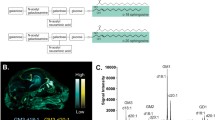Abstract
Gangliosides are specialized glycosphingolipids most abundant in the central nervous system. Their complex amphiphilic structure is essential to the formation of membrane lipid rafts and for molecular recognition. Dysfunction of lipid rafts and ganglioside metabolism has been linked to cancer, metabolic disorders, and neurodegenerative disorders. Changes in ganglioside concentration and diversity during the progression of disease have made them potential biomarkers for early detection and shed light on disease mechanisms. Chemical derivatization facilitates whole ion analysis of gangliosides while improving ionization, providing rich fragmentation spectra, and enabling multiplexed analysis schemes such as stable isotope labeling. In this work, we report improvement to our previously reported isobaric labeling methodology for ganglioside analysis by increasing buffer concentration and removing solid-phase extraction desalting for a more complete and quantitative reaction. Identification and quantification of gangliosides are automated through MS-DIAL with an in-house ganglioside derivatives library. We have applied the updated methodology to relative quantification of gangliosides in six mouse brain regions (cerebellum, pons/medulla, midbrain, thalamus/hypothalamus, cortex, and basal ganglia) with 2 mg tissue per sample, and region-specific distributions of 88 ganglioside molecular species are described with ceramide isomers resolved. This method is promising for application to comparative analysis of gangliosides in biological samples.







Similar content being viewed by others
References
Svennerholm L. Designation and schematic structure of gangliosides and allied glycosphingolipids. Prog Brain Res. 1994;101:XI-XIV.
Ceroni A, Maass K, Geyer H, Geyer R, Dell A, Haslam SM. GlycoWorkbench: a tool for the computer-assisted annotation of mass spectra of glycans. J Proteome Res. 2008;7(4):1650–9.
Sipione S, Monyror J, Galleguillos D, Steinberg N, Kadam V. Gangliosides in the brain: physiology, pathophysiology and therapeutic applications. Front Neurosci. 2020;14: 572965.
Bailey LS, Huang F, Gao T, Zhao J, Basso KB, Guo Z. Characterization of glycosphingolipids and their diverse lipid forms through two-stage matching of LC-MS/MS spectra. Anal Chem. 2021;93(6):3154–62.
Lee J, Hwang H, Kim S, Hwang J, Yoon J, Yin D, et al. Comprehensive profiling of surface gangliosides extracted from various cell lines by LC-MS/MS. Cells. 2019;8(11):1323.
Gahmberg CG, Andersson LC. Selective radioactive labeling of cell surface sialoglycoproteins by periodate-tritiated borohydride. J Biol Chem. 1977;252(16):5888–94.
Svennerholm L, Bostrom K, Helander CG, Jungbjer B. Membrane lipids in the aging human brain. J Neurochem. 1991;56(6):2051–9.
Chiricozzi E, Lunghi G, Di Biase E, Fazzari M, Sonnino S, Mauri L. GM1 ganglioside is a key factor in maintaining the mammalian neuronal functions avoiding neurodegeneration. Int J Mol Sci. 2020;21(3):868.
Sezgin E, Levental I, Mayor S, Eggeling C. The mystery of membrane organization: composition, regulation and roles of lipid rafts. Nat Rev Mol Cell Biol. 2017;18(6):361–74.
Martin SW, Glover BJ, Davies JM. Lipid microdomains–plant membranes get organized. Trends Plant Sci. 2005;10(6):263–5.
Cavdarli S, Yamakawa N, Clarisse C, Aoki K, Brysbaert G, Le Doussal JM, et al. Profiling of O-acetylated gangliosides expressed in neuroectoderm derived cells. Int J Mol Sci. 2020;21(1):370.
Wu G, Lu ZH, Gabius HJ, Ledeen RW, Bleich D. Ganglioside GM1 deficiency in effector T cells from NOD mice induces resistance to regulatory T-cell suppression. Diabetes. 2011;60(9):2341–9.
Li Z, Zhang Q. Ganglioside isomer analysis using ion polarity switching liquid chromatography-tandem mass spectrometry. Anal Bioanal Chem. 2021;413(12):3269–79.
Barrientos RC, Zhang Q. Isobaric labeling of intact gangliosides toward multiplexed LC-MS/MS-based quantitative analysis. Anal Chem. 2018;90(4):2578–86.
Andrews AT, Herring GM, Kent PW. The periodate oxidation of bovine bone sialoprotein, and some observations on its structure. Biochem J. 1969;111(5):621–7.
Reuter G, Schauer R, Szeiki C, Kamerling JP, Vliegenthart JF. A detailed study of the periodate oxidation of sialic acids in glycoproteins. Glycoconj J. 1989;6(1):35–44.
Tsugawa H, Cajka T, Kind T, Ma Y, Higgins B, Ikeda K, et al. MS-DIAL: data-independent MS/MS deconvolution for comprehensive metabolome analysis. Nat Methods. 2015;12(6):523–6.
Liebisch G, Drobnik W, Reil M, Trumbach B, Arnecke R, Olgemoller B, et al. Quantitative measurement of different ceramide species from crude cellular extracts by electrospray ionization tandem mass spectrometry (ESI-MS/MS). J Lipid Res. 1999;40(8):1539–46.
Land H, Humble MS. YASARA: a tool to obtain structural guidance in biocatalytic investigations. Methods Mol Biol. 2018;1685:43–67.
Yesmin F, Furukawa K, Kambe M, Ohmi Y, Bhuiyan RH, Hasnat MA, et al. Extracellular vesicles released from ganglioside GD2-expressing melanoma cells enhance the malignant properties of GD2-negative melanomas. Sci Rep. 2023;13(1):4987.
Inagaki FF, Kato T, Furusawa A, Okada R, Wakiyama H, Furumoto H, et al. Disialoganglioside GD2-targeted near-infrared photoimmunotherapy (NIR-PIT) in tumors of neuroectodermal origin. Pharmaceutics. 2022;14(10):2037.
Funding
Research reported in this publication was supported by the National Institute of Diabetes and Digestive and Kidney Diseases of the National Institutes of Health under Award Number R01DK123499.
Author information
Authors and Affiliations
Corresponding author
Ethics declarations
Ethics approval
Mouse tissues used in this work were collected under animal use protocol # 20025, which was approved by the Jackson Laboratory’s Bar Harbor Institutional Animal Care and Use Committee.
Conflict of interest
The authors declare no competing interests.
Additional information
Publisher's Note
Springer Nature remains neutral with regard to jurisdictional claims in published maps and institutional affiliations.
Supplementary Information
Below is the link to the electronic supplementary material.
Rights and permissions
Springer Nature or its licensor (e.g. a society or other partner) holds exclusive rights to this article under a publishing agreement with the author(s) or other rightsholder(s); author self-archiving of the accepted manuscript version of this article is solely governed by the terms of such publishing agreement and applicable law.
About this article
Cite this article
Smith, R.A., Zhang, Q. Region-specific mouse brain ganglioside distribution revealed by an improved isobaric aminoxyTMT labeling strategy with automated data processing. Anal Bioanal Chem 415, 7269–7279 (2023). https://doi.org/10.1007/s00216-023-04995-y
Received:
Revised:
Accepted:
Published:
Issue Date:
DOI: https://doi.org/10.1007/s00216-023-04995-y




